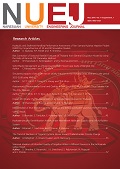Seasonal Variation of Microbial Quality of Irrigation Water in Different Sources in the Kathmandu valley, Nepal
Main Article Content
Abstract
River water, sewage, and groundwater are commonly used for irrigation in the Kathmandu valley, Nepal. However, data on their microbial quality is limited. In this study, 24 water samples were collected during the mid-rainy season (August 2015) from rivers, sewage, groundwater, ponds, a canal, and from effluent from a wastewater treatment plant (WWTP) in the valley. All samples were tested for waterborne protozoa (Giardia and Cryptosporidium) by fluorescence microscopy and for detection of indicator bacteria (Escherichia coli and total coliforms) by the most probable number (MPN) method using Colilert reagent. Positive ratios of 96%, 79%, and 50% were obtained for indicator bacteria, Giardia, and Cryptosporidium, respectively. The contamination level in the river water was as high as in the sewage. Indicator bacteria and protozoan concentrations were the highest for sewage and river water samples, and the lowest for groundwater samples. The results obtained were compared to those from a previous study for late-rainy (September 2014) and dry (April 2015) seasons. The mean concentrations of indicator bacteria and protozoa obtained in this study (mid-rainy season) were significantly lower than those reported in the dry season (t-test, p < 0.05). This corresponded well with the highest precipitation amount in August, and the lowest amount in April, suggesting dilution as a cause for the decrease in concentrations. Despite having lower concentrations than those reported in the dry and late-rainy seasons, all water samples, except one from groundwater, exceeded the WHO standards for E. coli for use in irrigation, indicating strong contamination of irrigation water. Positive correlations and stability of the regression line between indicator bacteria and protozoa concentrations for all seasons suggested E. coli and total coliforms as rough indicators of protozoa contamination of irrigation water.


